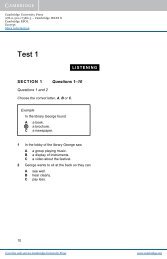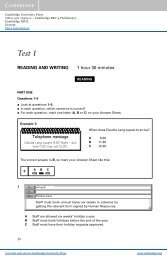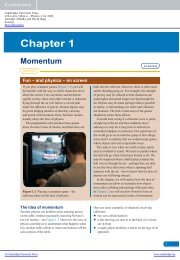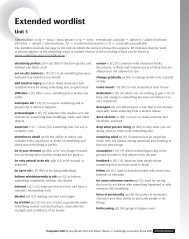Skills for Study Level 2 Teacher's Book - Cambridge University Press
Skills for Study Level 2 Teacher's Book - Cambridge University Press
Skills for Study Level 2 Teacher's Book - Cambridge University Press
You also want an ePaper? Increase the reach of your titles
YUMPU automatically turns print PDFs into web optimized ePapers that Google loves.
2hAnswersDefinition of contrappostoA classical technique used in the visual arts to make a human <strong>for</strong>m appearmore lifelike. In contrapposto, the weight of the subject is taken on one foot tocreate the impression of movement.The historical periods when contrapposto was used in artWas used in the Classical period and also during the Renaissance periodin Italy.The difference between Albrecht Dürer’s work be<strong>for</strong>e and after visiting Italy in 1495:Be<strong>for</strong>eDoes not use Classical effects (yet even so appears more natural than his workafter returning from Italy).AfterUses effects from Classical art, such as contrapposto, in his work.2iAnswersNote: Text B is reproduced below. Differences between this and Text A areunderlined; comments about the implication of the change are given in italics.Text B‘Contrapposto’ is a classical technique used in the visual arts to make the human<strong>for</strong>m appear more lifelike, or dynamic (more definite statement than Text A). Insculpture and drawings of the human body, the weight of the subject is takenon one foot, with the arms and shoulders twisting away to create movement(again, this is more certain). During the Middle Ages this technique was never used,with artists unconcerned about creating true-to-life impressions of human beings(strong statements without caution). This technique was revived in RenaissanceItaly and can be seen in the work of fifteenth- and sixteenth-century artists fromacross Europe.The German artist Albrecht Dürer first visited Italy in 1494, with his sketches fromaround the time of this visit inspired by classical art (implies all of his sketches,from be<strong>for</strong>e and after 1494, inspired by classical art; Text A states only after 1494are there classical influences). It is worthwhile to compare Dürer’s 1493 drawing ofa bathhouse girl with his 1495 drawing of a woman seen from the back (no explicitexplanation as to why, unlike Text A). Dürer’s 1495 drawing is of classical sculpture:it imitates classical models (again, definite about what the artist is doing, unlike TextA which is less certain). His subject is standing according to classical contrapposto:she is ready <strong>for</strong> action, with her weight taken on the right leg (again, more certainty).In spite of this technique, which creates greater realism, the pose is not natural (nocaution). In fact, compared to his 1493 drawing of a bathhouse girl, who is standingupright with no attempt to imitate classical sculpture or use contrapposto, the 1495drawing is unnatural, with an unrealistic posture (stronger claim).It is a matter of debate why the 1493 drawing, which does not attempt contrapposto,manages to create a more convincingly natural, or realistic, impression of a woman’sposture than the 1495 drawing (stronger claim). Dürer felt that he had createdcontrapposto in his 1495 drawing, and there<strong>for</strong>e a more natural look, and wished togive an impression of the classical sculpture he had seen on his travels (how doesthe writer know this? No caution and could be contested easily by the reader).Unit 4 Part B ∙ Understanding written in<strong>for</strong>mation 114
















